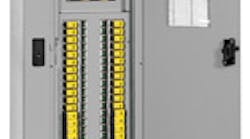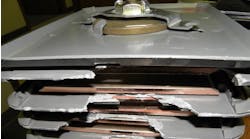Meeting NEC 2008 requirements for selective coordination in emergency and legally required standby systems can prove challenging for even the most knowledgeable electrical engineer or contractor. To help solve this often complex and time-consuming process, St. Louis-based Cooper Bussmann recently introduced the Quik-Spec Coordination Panelboard (QSCP), a fusible coordination panelboard that the company says eliminates the need for plotting extensive time-current curves or performing costly studies — all within the same footprint as conventional panelboard designs.
“QSCP was not only developed to eliminate the physical compromises inherent with traditional fusible coordination panelboards, such as the bulky 28-in. width of the panels, but also their limited design flexibilities and higher price,” says Kevin Hug, senior product manager for Cooper Bussmann.
Launched in October 2008, the panelboard is targeted toward the new construction market where selective coordination is required by the NEC in emergency systems, legally required standby systems, health care essential electrical systems, and critical operation power systems (COPS) per 700.27, 701.18, 517.26, and 708.54.
According to Hug, one of the product's key design considerations and the greatest technical challenge to overcome was developing a fused disconnect switch the size of a standard 1-in.-wide branch circuit breaker for use in the branch location of the panelboard.
“We accomplished that with our new UL-listed fused disconnect switch, the Compact Circuit Protector Base (CCPB) with CUBEFuse,” he notes. “This fused branch disconnect replaces the circuit breaker and Class CC fuse holder combination used in most 28-in.-wide fusible panelboards today. The use of the CCPB gives the QSCP a 20-in. width, matching that of a circuit breaker panelboard.”
Peter Holzemer, a senior design engineer for DEI Electrical Consultants in Spokane, Wash., says he is impressed with the product's compact size.
“These new panels fit in tight electrical closets,” says Holzemer, who designed the panelboard for the Washington State Penitentiary Health Service Building in Walla Walla, Wash. “It also works and lays out the same as standard electrical breaker-only panels.”
Available up to 60A, the CCPB is rated at 600VAC with a short circuit current rating (SCCR) of 200kA. To increase safety, the CCPB and finger-safe CUBEFuse are designed with a fuse ampacity-rejection feature to prevent overfusing, and an interlock that prevents removal of the fuse while it is energized. For faster troubleshooting, the CCPB includes a neon open-fuse indicator.
“With the QSCP, full fuse-system selective coordination is easy to achieve from source to branch,” remarks Hug, “Users simply follow published fuse selective coordination ratios.”
Offered in flexible configurations of up to 600VAC, 200A, and a 200kA SCCR with either a fused or non-fused main disconnect switch or main lug only (MLO) configuration, a choice of 18-, 30-, and 42-branch positions are available in NEMA 1 or NEMA 3R enclosures. Each panelboard also includes a 6-space spare fuse holder.
“This product solved the selective coordination required by NEC 700.27 without being overly complicated,” adds Holzemer.
Pricing for the panelboard is comparable with circuit breaker solutions of a much lower SCCR, according to Hug.
For additional information on the Cooper Bussmann Quik-Spec Coordination Panelboard, please visit www.cooperbussmann.com.



